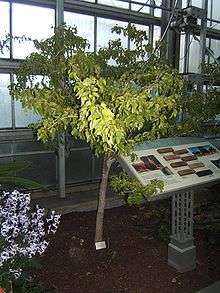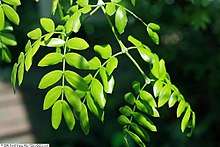Guaiacum sanctum
Guaiacum sanctum, commonly known as holywood or holywood lignum-vitae, is a species of flowering plant in the creosote bush family, Zygophyllaceae. It is native to tropical America, from Mexico through Central America, Florida, the Caribbean, and northern South America.[3] It has been introduced to other tropical areas of the world. It is currently threatened by habitat loss in its native region.
| Guaiacum sanctum | |
|---|---|
 | |
| specimen at United States Botanic Garden | |
| Scientific classification | |
| Kingdom: | Plantae |
| Clade: | Tracheophytes |
| Clade: | Angiosperms |
| Clade: | Eudicots |
| Clade: | Rosids |
| Order: | Zygophyllales |
| Family: | Zygophyllaceae |
| Genus: | Guaiacum |
| Species: | G. sanctum |
| Binomial name | |
| Guaiacum sanctum | |
| Synonyms[2] | |
Guaiacum sanctum is the national tree of the Bahamas.[4]
Properties
This small tree is slow growing, reaching about 7 m (23 ft) in height with a trunk diameter of 50 cm (20 in). The tree is essentially evergreen throughout most of its native range. It is shade tolerant. It fruits between the age for 30 and 70 years over the summer months in the Northern Hemisphere.[2]
The wood is hard, heavy and self-lubricating and has a Janka Hardness Score of 4500,[5] which is one of the hardest in the world. It can sink when placed in water.[6] There are fine ripple marks on the wood.[7]

Uses
This tree is one of two species which yield the valuable Lignum vitae wood, the other being Guaiacum officinale.
The wood has been used for making specific parts of ships that needed to be self-lubricating so that they would last longer.
The tree is considered to have medicinal value, used mostly for home remedies. The naturalist William Turner noted in 1568 that the plant was already being grown in India, Tamraparni (ancient Sri Lanka), Java and the Tivu islets of the ocean, and whose broth cured several harsh diseases, including French pox (Syphilis).[11][12] The bark can be steeped to create tonics.[4] It is also used as an ornamental plant.[8]
Threats
The type of rainforest (tropical-deciduous and dry forests) that holywood is found in are the most threatened ecosystems in the world.[2]
The plant was exploited until it was endangered due to use for timber and medical resin. Deforestation also occurred to create more human managed areas like farmland, cities, etc.[2] This has caused habitat fragmentation for the species, which reduces the chances of lowering its risk status.[13] Moreover, since this is a slow growing tree, it becomes harder to regrow and maintain sizable forests of it. It can be cultivated to grow faster, but needs to be watered regularly and to have well drained soil.[10]
It has no major pests[10] and though there were cases of illegal trade in 2008, this is no longer a major threat to the species.[2]
References
- Rivers, M.C. (2017). "Guaiacum sanctum". IUCN Red List of Threatened Species. 2017: e.T32955A68085952. Retrieved 11 August 2020.
- "Guaiacum sanctum". Germplasm Resources Information Network (GRIN). Agricultural Research Service (ARS), United States Department of Agriculture (USDA). Retrieved 2009-12-06.
- U.S. National Plant Germplasm System
- "National Symbols of the Bahamas". Bahamas Facts and Figures. TheBahamasGuide. Retrieved 2009-01-27.
- Friedrich, K; Akpan, E; Wetzel, B (16 May 2017). "Structure and mechanical/abrasive wear behavior of a purely natural composite: black-fiber palm wood". Journal of Materials Science. 52 (17): 10217–10229. doi:10.1007/s10853-017-1184-5.
- "Guaiacum sanctum". Nature's Notebook. National Phenology Network. Retrieved 2018-04-15.
- Record, Samuel J. “Tier-Like Arrangement of the Elements of Certain Woods.” Science, vol. 35, no. 889, 1912, pp. 75–77. JSTOR, JSTOR, www.jstor.org/stable/1638125.
- "Guaiacum sanctum - Plant Finder". www.missouribotanicalgarden.org. Retrieved 2018-04-16.
- "Holywood lignum vitae (Guaiacum sanctum)". Wildscreen Arkive. Wildscreem. Archived from the original on 21 September 2015. Retrieved 15 April 2018.
- Stubbins, Mark (1999). Flowering Trees of Florida. Florida: Pineapple Press. pp. 78–81.
- Turner, William (1995). William Turner: A New Herball: Parts II and III. Cambridge University Press. p. 670. ISBN 9780521445498. Retrieved 14 June 2019.
- MUNGER, ROBERT S. “Guaiacum, the Holy Wood from the New World.” Journal of the History of Medicine and Allied Sciences, vol. 4, no. 2, 1949, pp. 196–229. JSTOR, JSTOR, www.jstor.org/stable/24619141.
- Eric J. Fuchs, James L. Hamrick; Genetic Diversity in the Endangered Tropical Tree, Guaiacum sanctum (Zygophyllaceae), Journal of Heredity, Volume 101, Issue 3, 1 May 2010, Pages 284–291, https://doi.org/10.1093/jhered/esp127
External links



